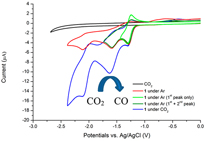Publication
875
Organometallics, 38 (6), 1351-1360, 2019
DOI:10.1021/acs.organomet.8b00588
|
|
|
|
|
|

|
Electrochemical and Photochemical Reduction of CO2 Catalyzed by Re(I) Complexes Carrying Local Proton Sources |
|
|
|
Laura Rotundo, Claudio Garino, Emanuele Priola, Daniele Sassone, Heng Rao, Bing Ma, Marc Robert, Jan Fiedler, Roberto Gobetto, and Carlo Nervi
University of Torino, Department of Chemistry, via P. Giuria 7, 10125 Torino, Italy
Université Paris Diderot, Sorbonne Paris Cité, Laboratoire d’Electrochimie Moléculaire, UMR 7591 CNRS, 15 rue Jean-Antoine de Baïf, Paris Cedex 13 F-75205, France
The Czech Academy of Sciences, J. Heyrovský Institute of Physical Chemistry, Dolejškova 3, 18223 Prague, Czech Republica
The novel rhenium complexes fac-Re(pdbpy)(CO)3Cl (pdbpy = 4-phenyl-6-(phenyl-2,6-diol)-2,2'-bipyridine), 1, and fac-Re(ptbpy)(CO)3Cl (ptbpy = 4-phenyl-6-(phenyl-3,4,5-triol)-2,2'-bipyridine), 2, have been synthesized, and the single crystal X-ray diffraction (SC-XRD) structure of 1 was solved. The electrochemical behaviors of the complexes in acetonitrile under Ar and their catalytic performances for CO2 reduction with added water and MeOH are discussed. A detailed IR spectroelectrochemical study under Ar and CO2 atmospheres coupled with DFT calculations allows the identification of reduced species and the interpretation of the reduction mechanisms. Comparison between the rhenium complexes and the corresponding Mn derivatives Mn(pdbpy)(CO)3Br, 3, and Mn(ptbpy)(CO)3Br, 4, has been also considered. Finally, photostimulated conversion of the CO2 was investigated with catalysts (1, 3, and 4) under visible light irradiation (lambda > 420 nm) in acetonitrile as solvent. Remarkably, 1 and 3 catalysts were active toward CO2, producing formate with good selectivity and turnover number (TON). For example, 3 gives 62% selectivity for HCOO-- and a TON of 80, and Re compound 1 gives 74% selectivity for HCOO- and a TON of 86. |

